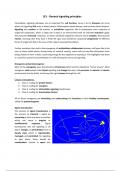Summary
Signaling & Techniques in I&I Lectures and Master Classes Summary
- Course
- Institution
This is a complete summary I made while following the (mandatory) Signaling & Techniques in I&I course. The key concepts of cellular signaling and (novel) research techniques are explained in this document. Alongside the lectures, master classes (MCs) are also given throughout the course. The notes...
[Show more]



